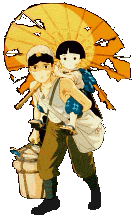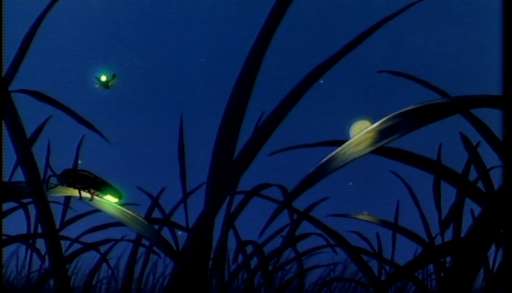Tombstone for Fireflies
by Freda Freiberg
Tombstone for Fireflies (1987 Japan 88mins)
Source: JIS Prod Co: Studio Ghibli Prod: Toru Hara Dir,Scr: Isao Takahata based
on Akiyuki Nosaka's novella Character design
Yoshifumi Kondo Phot: Nobuo Koyama Mus: Michio Mamiya
War orphan and post-war delinquent, Akiyuki Nosaka (born in 1930) won the
Naoki literary prize in 1967 for a pair of autobiographical novellas, Hotaru
no Haka and Hijiki America, which have unfortunately not been translated
into English to my knowledge. He is known in the West as the author of The
Pornographers, his first novel (originally published in 1963, and published
in Michael Gallagher's English translation in 1968), adapted in 1966 by Shohei
Imamura into a confronting "adult" movie.

It is hard to see any connection between Takahata's heart-rending, tender adaptation
of Hotaru no Haka and Imamura's black "introduction to anthropology".
Imamura's live action portrayal of obsession, lechery and perverse sexuality
in the life of the pornographer is decidedly unsuitable for children and disturbing
even for adults; its ugly world is rendered in harsh B&W cinematography.
Tombstone for Fireflies is not only animated and suitable for family viewing;
it is exquisitely beautiful with its painterly washes of colour and moments
of pure lyricism.
However, though Takahata has softened Nosaka's expiatory memoir, dark undercurrents
remain. Patrick de Vos has noted two obsessive themes in the work of Nosaka:
a morbid eroticism that is fundamentally incestuous; and grimacing death, over
whose mask hovers the shadow of a gentle nostalgia. Takahata renders the relationship
between older brother and baby sister loving and tender, and colours it strongly
with retrospective pathos; only in one scene (in the cave shelter at night,
when both are sleeping fitfully) does he hint at incestuous or pederastic desire.
But the film is littered with corpses- victims of bombing and starvation at
the end of the War. With his novella, Nosaka sought to exorcise his personal
sense of guilt at having alone survived the disasters of the war. But, his personal,
individual memory seeks to awaken the memory of History… and recalls to
us our humanity, by presenting it to us in states of crisis. Here the author's
voice of protest, full of rancour and revolt against a post-war Japan intent
on economic progress at any cost, already wells up. (1)
Takahata seems to share Nosaka's desire to arouse the memory of history, and
takes pains to remind his smug and prosperous compatriots (before the bubble
burst) of a repressed history of national and personal shame; to re-enact or,
more precisely, animate the death, destruction and suffering which were the
fruits of national imperialism and militarism. He shows people behaving selfishly
and callously in these devastating conditions; relatives, farmers, even doctors
are found wanting in humanity. But he also shows devotion and love (albeit carefully
inscribed in a retrospective narrative that smacks of special pleading or wishful
thinking) between brother and sister; and he shows them having fun, playing
games and exercising their imagination in life-enhancing ways. The ephemeral
fireflies, which fascinate the children and accompany them everywhere, become
a potent and lyrical symbol of the fragility, brevity and beauty of life.

This is a most unusual anime film. Far from the world of high-tech sci-fi horror-and-heroism,
far too from the fantasies for children, with their crusading heroes and heroines
who metamorphose into supermen and superwomen to vanquish evil. Even the delightful
ecological parables of Takahata's partner, Hayao Miyazaki, seem cute and childish
in comparison. The only other anime that I have seen which bears some resemblance
to it is Jinroh (screened at last year's Melbourne International Film
Festival). It similarly addresses modern socio-political history - opening with
documentary newsreel footage and inscribing its fictional narrative within a
history of the repression of the left in post-war Japan - and similarly ends
tragically rather than triumphantly. But it has a lighter touch, a gentler tone.
Jinroh is pervaded by a heavy brooding melancholy. Tombstone for Fireflies
does not wallow in mourning, or pile up the horrors; it is a work full of sorrow
and pity leavened by lyricism. It opens with the corpse of the narrator, lying
beside other corpses, discovered by a railway cleaner; it shows numerous other
deaths from bombing raids and starvation; and culminates in the protracted decline
and death of a child. But the piles of ashes are transmuted into showers of
fireflies. This is not a case of Christian redemption, whereby the spirit or
soul of the departed transcends death in some form of life everlasting. Rather,
in the tradition of Buddhist philosophy and art, it reminds us with exquisite
poignancy that, while all living things are finite and ephemeral, the cycle
of life, suffering and death is endless.
One may be reminded of another work of mourning, Kon Ichikawa's elegiac Harp
of Burma (1956), in which a sorrowing ex-soldier turns Buddhist priest and
undertakes the mission of locating and burying the corpses of his fallen comrades
throughout Burma. In both films, the strains of the otherwise trite melody,
"Home Sweet Home", are employed very tellingly and very movingly -
with heavy irony and excruciating pathos. One may also recall some other live-action
movies from other cultures centering on the experience of children in World
War II - Jeux Interdits (Forbidden Games, Rene Clement, 1952) and Ivan's
Childhood (Andrei Tarkovsky, 1962) spring to mind. One does not usually
associate anime films with realist art or genre movies, but I concur with Roger
Ebert's critical assessment of Tombstone for Fireflies: "it belongs on
any list of the greatest war films ever made". (2)
© Freda Freiberg, May 2001
Freda Freiberg is a film historian, critic and lecturer, whose specialist
research areas are Japanese cinema and (post-1970) Australian cinema. She is
especially interested in issues of culture and gender.
An English translation of Nosaka Akiyuki's short story upon which this anime
is based was published in the Japan Quarterly, Volume
25, No. 4, 1978.
Endnotes:
1.Patrick de Vos, "Nosaka Akiyuki", in Cinema et literature au Japon,
a publication of the Centre Georges Pompidou, 1986, p. 90.
2.Roger Ebert, "Grave of the Fireflies", Chicago Sun Times, March
19th 2000.
See also:
Grave of the Fireflies
a review by Jeffrey Overstreet
Copyright © 2002 by Jeffrey Overstreet.
Reproduction is forbidden without permission of the author.
Contact Jeffrey Overstreet at promontory@aol.com.
"Grave of the Fireflies" is a treasure, and one of the most haunting
war films I
have ever seen. And it's a cartoon.
This is the story of two children in Kobe, Japan. They are on the run from the
terrors of World War II, dodging Allied napalm bombs as they hurry into
shelter. We are used to seeing the war from the other side and cheering for
the
Allied Forces. This film does not glorify the Japanese or the Germans, but it
puts us in the shoes of the common Japanese workers and their children, who
were caught up in the conflicts of powerful nations and who had no choice but
to run for their lives as the consequences played out.
Seita, the teenage son of a Japanese naval officer, strives to comfort his young
sister Satsuko as relentless bombing raids burn and destroy large sections of
their city. Their struggle for food, for survival, and for hope as their neighbors
turn more self-centered and hard-hearted makes "Fireflies" a compelling
and
devastating story.
The only animated film I think compares to it in tone and impact is, perhaps,
"Watership Down". Both films go to great lengths to portray the natural
world
in realistic detail. They pay such close attention to ordinary details of a
conversation or a setting that these details take on profound, poetic significance.
Both films look at the cruelty of humankind, the insensitivity to the poor and
the
needy, the way all that we take for granted can so easily disappear, the way
people tend to behave like animals when crises strike. And both are enhanced
by
delicate, subtle, beautiful soundtracks.
You won't be blown away by clever dialogue or plot twists. Things pretty much
go the way you hope they won't, and that's no surprise, as we all know how
the war ends. And yet, the mastery of light in different environments (a
firestorm at night, a firefly in a tent, morning sun on a field and on a beach)
is
remarkably beautiful. The pacing and frequent, short shots of tools, furniture,
plants, and faces efficiently deliver a wealth of information about the place,
the
time, the "lived-in" quality of this neighborhood.
Such detail does a great service to the audience. It breaks down the assumed
walls between "us" and "them". It will make you feel that
you are watching the
Allies bomb not the "enemy", but our neighbors, brothers, and sisters.
This is not Disney. There are no heroes coming to save the day. Sickness is
not
healed by a miracle. But love remains and offers hope.
Some would call the film sentimental. I don't think so. Each moment of emotion
is earned because we have become intimately acquainted with the characters.
They are not undeveloped, but they *are* ordinary. Their conversations don't
feel scripted. They are as plain as real conversations. Their needs and solutions
to problems are not intelligent beyond the years of poor, anxious children.
They
are completely believable.
I often struggle with my suspension of disbelief watching anime. The
exaggerated eyes bug me. But these drawings are more human-scale. And they
are quite expressive. They seem inspired by the marvelous, whimsical
characters of another anime master, Hiyao Miyazake. In fact, if anything about
the film bothered me, it was that Satsuko seemed a bit too similar to the tiny
tot
at the center of "My Neighbor Totoro".
This is a beautiful lament, and a moving tribute to the people we rarely consider
when we think about World War 2. The common people of Japan who suffered
so mightily for the crimes of their leaders. The children who lost everything
as
the Allies struck. A thousand American movies have exploited the situation,
giving us a stereotype of the cold, evil Japanese warrior. Now there is one
that
represents the many who died and the countless who were sorely wounded, in
body and in spirit, at the hands of our own military.
The film in no way denounces the motives of the Allies. In fact, it ignores
the
politics of the situation almost entirely. After all, the experience of children
rarely encompasses political discourse. All they know are the frightening sounds
and sights of the wars that grownups wage. And that is something we must
consider carefully as we grownups make decisions about future conflicts. This
movie gives us a context in which to consider the impact of those choices we
sometimes face. And may God have mercy on our souls.
Note the following:
There is no maudlin sentiment here, no deliberate manipulation of the
viewer's feelings. It all unfolds in quiet dignity, and breaks the viewer's
heart. I could not bear to watch it in its entirety, but had to view it
in two sittings, a week in between.
There is no need to talk about the animation, to try to justify it as a
valid means of serious cinematic expression. It is a masterpiece of World
Cinema, one of the most searlingly intense depictions of war and its consequences
ever created by anyone, anytime.
Gary Tooze


